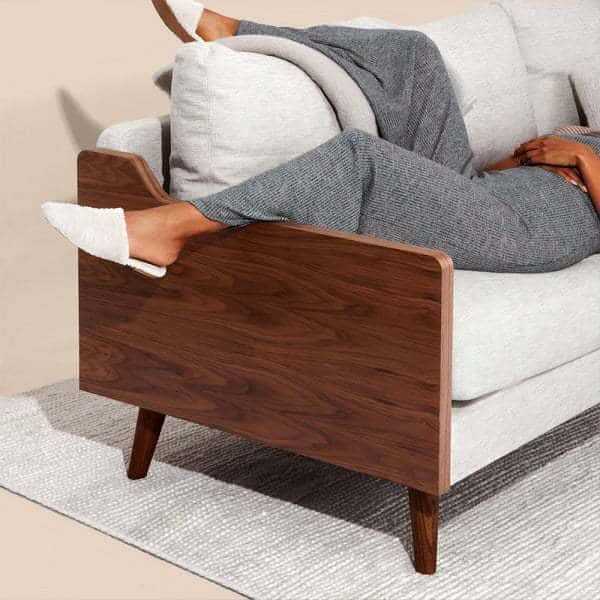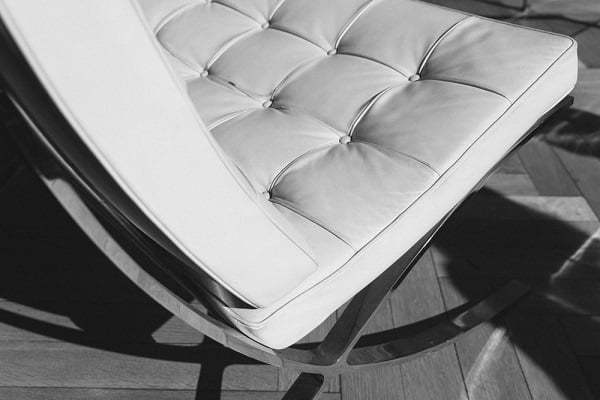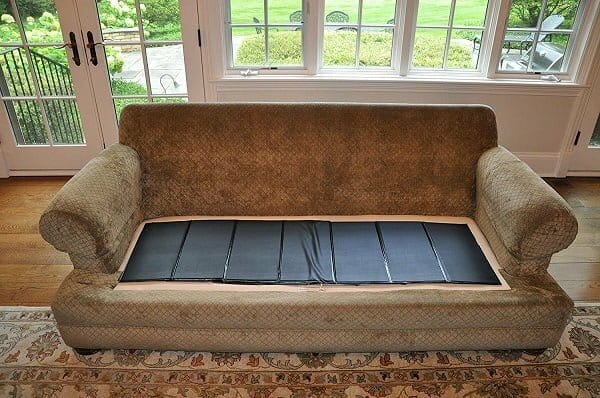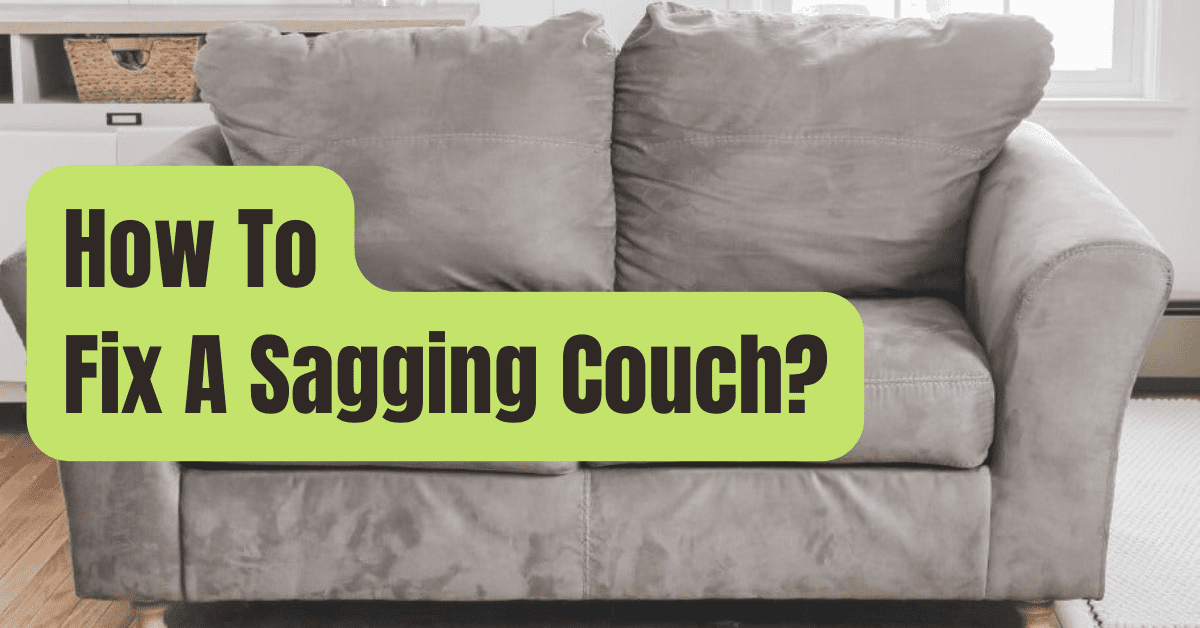Do you live in a house with a drooping couch? Want to save money on repairs by doing them yourself? This guide will assist you in accomplishing your goal.
A drooping sofa is a sight to see.
It’s a blight on your interior design.
To say the least, it’s not a very comfy piece of furniture.
As a result, you must correct it immediately.
But how do you do it? Why not hire a handyman? Should I take it to a repair shop? Bringing a sofa out and back into the home may be costly and inconvenient.
You’re a family hero if you can repair it yourself.
Right now, we’ll teach you how to become one.
This tutorial is easy to follow, and it includes numerous key videos that you should view.
We’ve also added some really valuable links.
Our objective is to become a one-stop shop for all of your sagging sofa repair requirements.
Repairing a Couch
Your couch’s sagging is an indication that something is wrong with it.
In order to repair the sofa, you’ll need to do some tests to figure out what’s causing the sag.
These include inspecting the cushions; if they are firm and comfortable, you may on to inspecting the structure and springs.
This might include carefully removing staples from the dust covers or cutting a line around the edge of the sofa using a sharp utility knife.
It’ll be simpler to execute the checks and then reattach the cloth when the evaluation is over if you do it this way.
How to Fix a Sagging Couch on Your Own
So you’ve got that sinking sofa and you’re certain you can fix it.
Hiring a repairman or transporting it to a repair shop is, indeed, an expensive and time-consuming process.
The do-it-yourself method is much more efficient.
But only if you’re sure what you’re doing.
#1. What Should You Check First?
- What’s the problem? Is it the frame, the springs, or only the cushions that are causing the problem?
- To find out, remove the cushions from the sofa and flip it over.
- Is it the drooping cushions alone?
- Is there any cracked or damaged wood in the frame?
- Are there any springs that are bent?
#2. What Can You Do About It?
- Cushions are simple to repair and you may do it yourself. All you have to do now is replace the filler and the batting.
- The wooden frame’s broken portions will need to be replaced. This entails working with wood. Metal brackets may be used to repair it in certain circumstances.
- To fix springs you’ll need specialized equipment or to consult a professional.
In this essay, we’ll go through each of the topics mentioned above.
Support for the Couch
All couches are built differently, but they all have a metal or wood support frame in common.
Provide stability for timber frames by strengthening or replacing damaged portions.
Metal frames are more difficult to repair; but, bent portions may be fixed.
#1. Couch Made of Wood
This is the most common couch frame style.
It’s also the simplest to repair if it breaks.
The planks that hold the frame of wood couches may break and cause drooping.
The wood and screws will need to be replaced if this is the case.
Take the slats’ measurements and go to a hardware shop to repair the shattered sections.

#2. Couch Made of Metal
Metal frames are more durable and shatter less often.
If the frame is damaged or bent, you’ll need to straighten it out or weld it back together.

Couch Springs is a town in Colorado.
Typically, inspecting the springs necessitates removing the majority of the upholstery fabric.
Determine whether the springs are broken or bent.
If the sagging is caused by bent springs, you may be able to fix them using pliers.
However, if they are broken, professional intervention may be required.
Support for Couch Cushions
You may use polyester fiberfill to offer stability and repair the sag in cushions with loose filling.
Quilt batting may be wrapped over other cushions that require firming and have lost their form.
#1. Couch Cushions Replacement
Replacing sofa cushions is a simple and cost-effective task.
This will make your sofa seem “as good as new” without costing a lot.
The best part is that this job can generally be completed in a short period of time.

#2. Sofa Cushion Inserts Replacement
A complete foam padding replacement is often more durable and delivers the greatest results than alternative materials.
Choose pieces that are comparable in size and form to the current cushions.
Sharp scissors or a utility knife may be used to achieve the desired shape if necessary.
To ensure that the inserts fit tightly, properly measure the foam.
#3. Couch Protector
These lifts are particularly designed to alleviate sag by providing enough support.
Between the cushions and the top of the frame are these hard-plastic or vinyl bits.
They’re particularly useful if the problem includes a few broken springs or cushions that are slightly out of shape.

#4. What Foam Should You Use for Sofa Cushions?
Foam comes in a variety of shapes and sizes, each designed to drain water, float, resist mildew and mold, and withstand everyday use.
Choose a foam that has properties that are suitable with the way you want to use it.
When purchasing foam, density is a vital consideration; the greater the density, the longer the sofa will last.

Couch Cushions: How to Replace Them
Sagging sofa cushions may be easily remedied by replacing them.
This gives the appearance of a brand new sofa for a fraction of the price.
This is how you do it:
- Take images of your previous sofa so you have something to compare it to.
- Take the cushions’ coverings off.
- Measure the cushions’ width, length, and depth.
- Purchase new cushions or create your own to the precise proportions.
- Replace the old coverings with the new cushions. If you like, you may also replace the covers at this time.
- Replace the cushions on the sofa.
#1. Couch Cushion Covers with Zippers
Zippered cushion coverings are a simple and effective technique to remedy sagging sofas.
Hidden zippers in the upholstery may be found on most couch cushions.
All that’s needed is to physically remove the cushions from the sofa, unzip the covers, and fluff the filling.
To correct the sagging problem, the stuffing that has been moved to the side and elsewhere will be re-distributed.

#2. Couch Cushion Re-stuffing
Re-stuffing is a fantastic technique to restore the contour of your sofa.
You may usually buy extra of the same sort of filling that is in the cushion, although this isn’t always required.
To provide additional volume, almost any form of filling may be employed.
#3. Back Cushions for Sofas
Each cushion should have a zipper on the bottom that allows you to access the stuffing.
Simply unzip it and fluff it with both hands until you get the desired result.
Move about and play with the cushions, paying specific attention to the droopy places.
It should take less than a minute to fluff up each cushion.

Couch Cushions (DIY)
You may even construct your own replacement cushions if you want to take this DIY project to the next level.
This method has the advantage of producing precisely what you want.
Sewing machine, cloth, scissors, pins, foam cushions, cable, and glue are common equipment and supplies required.
To get started, follow these steps:
- Cut two pieces of cloth depending on the cushion’s dimensions. Make sure to leave enough fabric for the seam allowance.
- The upholstery fabric must be bonded around the cable and the cording cloth must be trimmed on the bias. Take a measurement of the cushion’s circumference. Cut the cloth to suit the cushion’s circumference and breadth. Stitch the cord to the long lengths of cloth on both sides.
- All of the pieces should be placed with the insides facing out. After then, stitch the additional pieces of cloth to the corded strip. Make careful to allow room for the cushion to be inserted. Turn the cloth over, stuff the cushion, and stitch the fourth side together.
- Cut two pieces of fabric to the desired pillow size, being sure to leave enough fabric for a seam allowance.
- Sew around three of the sides of the two pieces of cloth, wrong sides together. Stitch around the corners on the opposite side, leaving a hole for the pillow insert. Place the cushion on the correct side of the cloth. After pinning the aperture shut, hand stitch it shut.
How to Use Plywood to Repair a Sagging Couch
If the structure of your sinking sofa is weak or damaged, a piece of plywood might be used as a simple remedy.
Keep in mind that this is more of a band-aid solution, and you’ll need to replace the main frame eventually.
Plywood not only gives support to the cushions, but it also makes them much firmer.
This may not be what you’re looking for.
To use plywood to repair sagging cushions, you must first remove the cushions.
Take a measurement of the area of the sofa that will need the wood.
Remove the cushions, cut the plywood, and reinstall it.

FAQs
How do you prevent your sofa cushions from sinking?
Under the cushions, place a sofa saver board or thin plywood.
What is the best way to protect sofa cushions from sliding?
Under the cushions, place a non-slip rubber underlay.
How do you mend a sinking sofa with cushions attached?
Flip the sofa over.
Remove the dust cloth from the room.
A concealed zipper usually enables you to access the cushion filling, which you may change.
How can I make the cushions on my sofa firmer?
For further stability, use plywood or particleboard beneath the cushions.
What is the best way to repair drooping sofa springs?
Determine which springs are twisted and attempt to repair them.
How to repair a sinking pull out couch?
Fix it the same way you’d fix ordinary cushions.
You’ll need to get to the filler, which you may accomplish by looking for the cover zipper.
How do you fix a leather sofa?
Underneath the leather sofa, the cushion filler may be accessed.
As a result, flip the sofa over and re-inflate the cushions.
Where can I get sofa cushion replacement foam?
Cushion foam is available at any hardware shop.
You may also try your luck online at Amazon, eBay, and other retailers.










